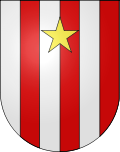Echarlens
| Echarlens | |
|---|---|
| State : |
|
| Canton : |
|
| District : | Gruyère |
| BFS no. : | 2131 |
| Postal code : | 1646 |
| Coordinates : | 572098 / 166440 |
| Height : | 716 m above sea level M. |
| Height range : | 674–910 m above sea level M. |
| Area : | 4.65 km² |
| Residents: | 840 (December 31, 2018) |
| Population density : | 181 inhabitants per km² |
| Website: | www.echarlens.ch |
| Location of the municipality | |
Echarlens ( Freiburger Patois ) is a municipality in the Gruyère district of the canton of Friborg in Switzerland . The former German name Schärlingen is no longer used today.
geography
Echarlens is 716 m above sea level. M. , 3.5 km north-northeast of the district capital Bulle (linear distance). The clustered village extends in the valley east of the Sionge stream , at the southeast foot of the Gibloux , west of Lake Gruyère .
The area of the community area of 4.6 km² comprises a section of the Bulle basin in the foothills of the Friborg Alps . In the east, Echarlens has a share of the lake area of Lake Gruyère. From here, the municipality extends westward over a relatively steep bank section to the plateau between the Sionge and the reservoir. This plateau is bounded in the south by the forest height Vaucens , in the north by the hill Joux d'Everdes (at 807 m above sea level the highest point of Echarlens). To the west of the plateau, the area extends into the lower Sionge valley. A small exclave is located west of Riaz on the southern slope of Sur les Monts . In 1997, 8% of the municipal area was settled, 15% forest and woodland, 75% agriculture and around 2% was unproductive land.
Echarlens includes the hamlets of Champotey ( 780 m above sea level ) on the southern slope of the Joux d'Everdes, Bocherens ( 719 m above sea level ) and Fontanoux ( 722 m above sea level ) on the plateau, as well as some individual farms. Neighboring municipalities of Echarlens are Bulle , Riaz , Marsens , Corbières and Morlon .
population
With 840 inhabitants (as of December 31, 2018) Echarlens is one of the smaller communities in the canton of Friborg. 92.4% of the residents are French-speaking, 3.3% German-speaking and 2.2% Portuguese-speaking (as of 2000). The population of Echarlens was 440 inhabitants in 1850 and 446 inhabitants in 1900. After a peak around 1920 (479 inhabitants), the population decreased by almost 30% to 337 people by 1970 due to strong emigration. Since then, the population has increased rapidly again (especially during the 1990s).
economy
Until the second half of the 20th century, Echarlens was predominantly an agricultural village. Even today, livestock and dairy farming and, to a lesser extent, arable farming play an important role in the income structure of the population. Further jobs are available in local small businesses and in the service sector. In the last few decades the village has developed into a residential community. Most of the gainfully employed are therefore commuters who work in the Bulle or Freiburg regions.
traffic
The community has good transport connections. It is located near the main road from Freiburg to Bulle ; a connecting road leads with a bridge over a narrow part of the Gruyère lake to Corbières . The next connection to the A12 motorway , which has been open continuously from Bern to Vevey since 1981, is around 3 km from the town center. Echarlens is connected to the public transport network by the Freiburg public transport bus line , which runs from Bulle via La Roche to Freiburg.
history
The municipality of Echarlens was settled very early on, which is evidenced by traces from the Hallstatt period and the remains of a Roman estate that was inhabited from the 1st to 3rd centuries AD. The place was first mentioned in a document in 851 under the name Escarlinges . Later the names Scarlens (1145), Escharleins (1225), Eschallens (1228), Echarlans (1668) and Echerlens (1806) appeared. The place name is derived from the Burgundian personal name Skarilo and means with the suffix -ens as much as the people of Skarilo .
Since the Middle Ages , Echarlens belonged to the dominion of Corbières, came in 1225 when the parts to the west of the Saane were split off to the newly formed dominion of Vuippens and when they were divided in 1269 to the dominion of Everdes. Everdes Castle was located in what is now the municipality. As part of the effects of the Burgundian Wars , Echarlens came to Freiburg in 1475, which provided the kastlan who held office at Everdes Castle.
In 1553 Echarlens was assigned to the newly founded Bailiwick of Vuippens-Everdes. After the collapse of the Ancien Régime (1798), the village belonged to the Bulle district during the Helvetic and the subsequent period until 1848, before it was incorporated into the Gruyères district.
Attractions
Echarlens was a parish as early as the 11th century. Today the village has two churches and two chapels. The current church was built between 1924 and 1927 according to plans by the architect Fernand Dumas . The previous church, built in 1626, is no longer in use.
Web links
- Official website of the municipality of Echarlens
- Alain-Jacques Czouz-Tornare: Echarlens. In: Historical Lexicon of Switzerland .
- Aerial views of the village
Individual evidence
- ↑ Permanent and non-permanent resident population by year, canton, district, municipality, population type and gender (permanent resident population). In: bfs. admin.ch . Federal Statistical Office (FSO), August 31, 2019, accessed on December 22, 2019 .


